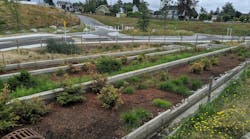Aerial Hydromulching Begins Over Angora Burn Area
The U.S. Forest Service, on Wednesday, began sending aerial hydromulch operations planes over the Angora fire burn area in South Lake Tahoe, Calif. Pilots will deposit hydromulch over 636 fire-damaged areas that are inaccessible for hand treatment; the hydromulch will help control erosion and prevent runoff.
The hydromulch minimizes soil erosion by sticking to the hillside and trapping in moisture. It promotes an environment favorable for seed sprouting and thus natural soil stabilization through vegetation.
"Aerial hydromulching has proven valuable in stabilizing burned hillsides," said Terri Marceron, forest supervisor for the Lake Tahoe Basin Management Unit. "Along with rice and wood straw treatments in urban areas and the removal of hazard trees throughout the burned area, it's a major component of our rehabilitiation plan.
Hydromulch is composed of an entirely organic mixture--wood mulch, recycled paper, water and a guar gum-based tackifier to bind the ingredients together--and poses no threat to humans or wildlife.
Hydromulch, while it will harden and turn gray after a few days on the ground, is dyed green and deposited in a wet tform so that pilots can initially monitor its coverage.
Aerotech Inc., Clovis, N.M., is serving as project contractor. The aerial hydromulch operations contract calls for 15 workdays through the end of September, weather-permitting. On each workday, four planes will fly from 8 a.m. to 8 p.m., or until dark.
National Forest lands within the Angora burn area remain closed, and forest protection officers will patrol the area and issue citations if necessary. "Walking or biking on the hydromulch will reduce the effectiveness of this soil-stabilization treatment," Marceron said.
Source: North Lake Tahoe Bonanza

